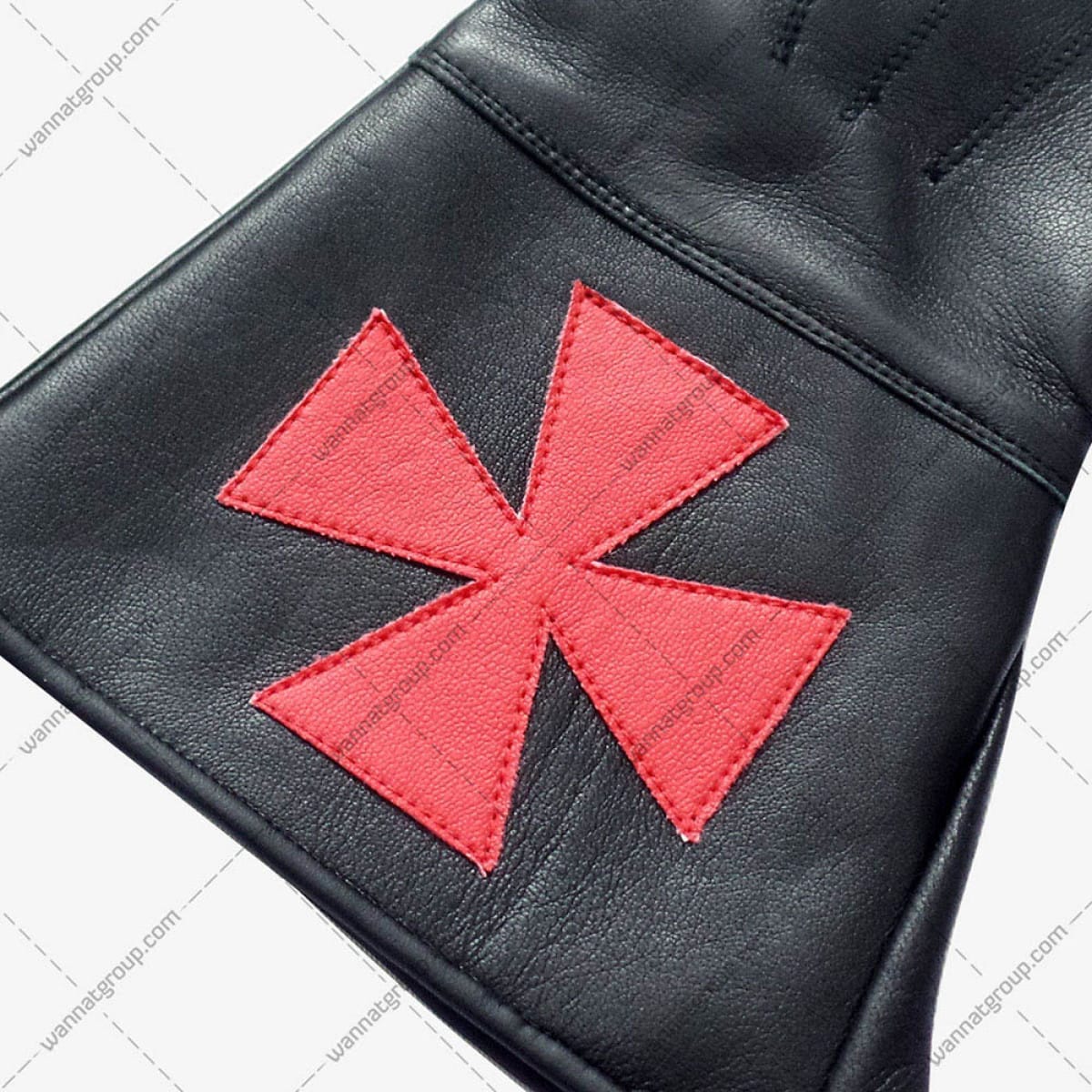Unlocking the Secrets of the Knight Templar Gauntlet: A Journey to 1200 AD
Journey back to the tumultuous era of the Crusades, where amidst the clang of steel and the thunder of hooves, the Knights Templar, an elite order of warrior monks, carved their place in history. Central to their formidable presence was the Knight Templar gauntlet, a marvel of medieval craftsmanship that not only safeguarded their hands but also embodied their indomitable spirit. Join us as we delve into the fascinating world of the Knight Templar gauntlet circa 1200 AD, exploring its intricate design, battlefield functionality, symbolic significance, and enduring legacy.
Anatomy of a Knight Templar Gauntlet: Protection, Flexibility, and Symbolism
Unlike the cumbersome hand coverings often depicted in modern media, the Knight Templar gauntlet of the 13th century was a masterpiece of both protection and flexibility. Imagine, if you will, a foundational layer of interlocking iron rings, meticulously woven to form a chainmail “glove.” This chainmail provided a surprising degree of defense against cuts and slashes while allowing the knight to maintain dexterity in his grip.
But the true ingenuity of the gauntlet lay in its reinforcement. Strategically placed plates of iron or steel, securely riveted over the chainmail, shielded vulnerable areas like knuckles, fingers, and the back of the hand. These plates, likely crafted to fit the individual knight, acted as a bulwark against crushing blows from maces, axes, or the pommel of a sword. Some gauntlets even featured articulated plates at the fingers, further enhancing the wearer’s range of motion – a critical advantage in the heart of close-quarters combat.
Beyond its practicality, the Knight Templar gauntlet was imbued with layers of symbolism. The interlocking rings of chainmail likely represented the unbreakable bond of brotherhood within the Templar order – each ring, though seemingly insignificant on its own, contributed to a larger, impenetrable whole. Additionally, engraved crosses or religious iconography on the plates may have served as a constant reminder of the knights’ dual roles as warriors of God and protectors of the Christian faith.
From Battlefield to Modern Day: The Enduring Legacy of the Knight Templar Gauntlet
Sadly, few original Knight Templar gauntlets from the 13th century have survived the ravages of time. Those that remain are highly prized artifacts, carefully preserved in museums and private collections around the world. These relics offer a tangible link to a bygone era, whispering tales of valor, faith, and the brutal realities of medieval warfare.
Want to know what good relationships result in order to achieve legalism or confucianism? Explore the connection here.
Interestingly, the legacy of the Knight Templar gauntlet extends far beyond museum displays. Modern Masonic Knights Templar, a fraternal organization inspired by the historical order, often incorporate stylized gauntlets into their regalia as a tribute to their predecessors. In popular culture, the image of the knight in shining armor, gauntlet raised in defiance, continues to captivate audiences in movies, television shows, video games, and literature.
For history enthusiasts and collectors, replica Knight Templar gauntlets are available, though it is crucial to note that quality and historical accuracy can vary significantly. Some artisans dedicate themselves to recreating these pieces using traditional methods, resulting in stunningly authentic reproductions. However, others may prioritize aesthetics over historical fidelity. If you’re considering acquiring a replica, thorough research is essential to ensure you’re investing in a piece that reflects the craftsmanship and spirit of the original.
The Knight Templar gauntlet of 1200 AD stands as a testament to a pivotal period in history. It embodies the perfect marriage of form and function, practicality and symbolism, offering us a glimpse into the lives of these legendary warrior monks and the brutal world in which they lived. As we continue to uncover new information about medieval armor and the Knights Templar, our understanding of these iconic gauntlets will undoubtedly continue to evolve, ensuring that their story, much like their legacy, lives on.
Does the Templar Order Still Exist? Myths, Legacies, and Modern Interpretations
The question of whether the Knights Templar still exist today is a complex one, often shrouded in speculation, romanticized notions, and a healthy dose of historical intrigue. While the original order was officially dissolved by papal decree in 1312, the Knights Templar have left an indelible mark on history, inspiring numerous groups and interpretations that carry on aspects of their legacy, even if not a direct lineage.
It is important to state unequivocally that no modern organization can claim direct, unbroken descent from the medieval Knights Templar. The Catholic Church, for its part, does not recognize any contemporary group as an official successor. The dissolution of the order in the 14th century, though fraught with controversy and accusations, effectively severed the direct line.
However, the Templars’ impact on history, particularly their contributions to military strategy, financial systems, and architectural techniques, coupled with the mystery surrounding their downfall, has fueled centuries of speculation and romanticized interpretations. This fascination has manifested in various forms, from charitable organizations that embody the Templars’ spirit of service to more esoteric groups that ascribe to alternative narratives and theories about their continued existence.
One prominent example of a modern organization that draws inspiration from the Knights Templar is the Masonic Knights Templar. This fraternal organization, with chapters around the world, incorporates Templar symbolism, rituals, and ideals into its Masonic practices, emphasizing chivalry, morality, and fraternal bonds. It’s crucial to understand that Masonic Templar organizations, while finding inspiration in the historical order, focus on personal development and charitable work, not crusading or military pursuits.
Another fascinating thread in the Templar tapestry is the Portuguese Order of Christ, established in 1319. This order, sanctioned by the Pope, absorbed many former Knights Templar and their assets, effectively providing a haven for those displaced by the dissolution. The Order of Christ played a significant role in Portugal’s maritime exploration during the Age of Discovery, further cementing the Templar connection to this pivotal period in history.
While some fringe groups promote less mainstream ideas about the Templars, often venturing into conspiracy theories or reinterpretations of history, these claims should be approached with a healthy dose of skepticism.
The enduring fascination with the Knights Templar speaks to their enduring mystique. Their story, a compelling blend of historical fact and enduring legend, continues to capture the imagination, inviting us to explore the complexities of faith, power, and the enduring allure of the past.
## What Happened to the Knights Templar on Friday, October 13, 1307? The Fall of an Order
The date, Friday, October 13th, 1307, has become synonymous with misfortune and bad luck. This association is not without reason, for it marks a pivotal and tragic day in the history of the Knights Templar. On this fateful day, King Philip IV of France, driven by a combination of factors likely including personal ambition, financial debt, and perhaps a degree of paranoia, orchestrated a series of coordinated arrests that would ultimately lead to the downfall of one of the most powerful organizations in medieval Europe.
Imagine, if you can, the scene unfolding across France as dawn broke on that Friday morning. Knights Templar, renowned for their military prowess, wealth, and influence, were seized from their beds, imprisoned, and accused of a litany of shocking crimes, including heresy, blasphemy, idolatry, and even obscene rituals. These accusations, vehemently denied by the Templars, were largely based on confessions extracted under duress—brutal torture at the hands of King Philip’s inquisitors.
The swiftness and coordinated nature of these arrests suggest a carefully calculated plan, orchestrated to cripple the Templar order swiftly and decisively. Historians have long debated King Philip’s motivations. Some argue that the king, deeply in debt to the Templars, saw an opportunity to eliminate his creditors and seize their considerable wealth. Others propose that Philip, increasingly wary of the Templars’ influence and autonomy, used accusations of heresy and immorality to dismantle a perceived threat to his authority.
Whatever the king’s true motives, the consequences for the Knights Templar were catastrophic. Under immense pressure from King Philip, Pope Clement V, perhaps fearing the king’s wrath or seeking to maintain a fragile political balance, ultimately agreed to dissolve the Templar order in 1312. While some Templars escaped, many were executed, their reputations tarnished, their lives cut tragically short.
The events of Friday, October 13, 1307, continue to fascinate and horrify in equal measure. The sudden downfall of such a powerful order, brought low by accusations, intrigue, and political machinations, serves as a stark reminder of the capricious nature of power and the fragility of even the most formidable institutions. The Knights Templar, once symbols of faith, chivalry, and military might, became victims of their own success, their story a cautionary tale that resonates even today.
Are There Any Knights Templar Today? Exploring Modern Templar Organizations
While the original Knights Templar ceased to exist as a unified order in the 14th century, their legacy continues to resonate in the modern era, albeit in fragmented and often misunderstood ways. Numerous organizations today lay claim to the Templar name and imagery, but it is essential to approach these claims with a discerning eye, as the landscape of modern Templar groups is varied and complex.
It bears repeating that no contemporary organization can definitively prove a direct, unbroken line of succession from the medieval Knights Templar. The Catholic Church does not recognize any modern entity as the official heir to the dissolved order. Therefore, any group claiming to be the “true” Knights Templar should be met with healthy skepticism.
However, this lack of a direct lineage does not diminish the fascination with the Templars or negate the sincere desire of many individuals to connect with their legacy. Modern Templar organizations can be broadly categorized into a few distinct groups:
1. Charitable and Historical Preservation Societies: These groups focus on upholding the positive aspects of the Templar legacy through charitable work, historical research, and the promotion of chivalric ideals. They do not claim to be warrior monks or a resurrected military order but rather seek to honor the Templars’ spirit of service and their contributions to history. Examples include the Grand Priory of Knights Templar in England and Wales, which focuses on charitable giving and supporting historical research related to the order.
2. Masonic Templar Orders: These groups, often integrated within the broader Masonic fraternity, incorporate Templar symbolism, rituals, and degrees into their practices. While drawing inspiration from the historical Knights Templar, Masonic Templar orders center their activities around fraternal bonds, personal development, moral uprightness, and charitable endeavors. They do not claim a direct historical lineage or engage in military activities. The United Religious, Military and Masonic Orders of the Temple and of St John of Jerusalem, Palestine, Rhodes, and Malta, despite their lengthy name, exemplifies this type of organization.
3. Fringe Groups and Esoteric Orders: These groups often espouse more controversial or unorthodox views about the Knights Templar, sometimes delving into conspiracy theories, alternative historical narratives, or claims of hidden knowledge passed down through the ages. Their connection to the historical order is often tenuous and based on speculation rather than verifiable evidence.
When encountering a modern group claiming a Templar connection, it’s essential to research their history, activities, and beliefs.
The enduring allure of the Knights Templar lies in their captivating history, their association with the Crusades, and the enduring mysteries surrounding their downfall. While the original order may be lost to time, their story continues to resonate, inspiring individuals and organizations to grapple with themes of faith, chivalry, and the enduring power of history.
- Unveiling Bernhard Caesar Einstein’s Scientific Achievements: A Legacy in Engineering - July 15, 2025
- Uncover who is Jerry McSorley: CEO, Family Man, Business Success Story - July 15, 2025
- Discover Bernhard Caesar Einstein’s Scientific Contributions: Unveiling a Legacy Beyond Einstein - July 15, 2025















